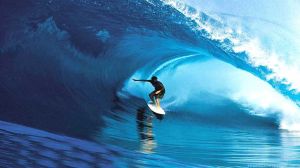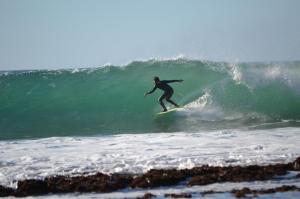To the mere civilian, the title of this post may cause much confusion; but to the average surfer this means they could be in for an intense session. Living in Cape Town and being married to a surfer has resulted in the necessity of weather awareness; the main variables to take note of are, the swirl of the ocean, the wind speed and the wind direction, all concluding with the size and consistency of the waves. From Muizenberg to Llandudno, Elands Bay to Jeffereys Bay; a great surf session relies on optimum surfing conditions, therefore creating the perfect waves.
Although, to have the BEST session in the water, it is more than just the elements that need to be in peak condition. For the past 6 months, I have been watching and researching surfing; the techniques, the skills needed, the common injuries, the bio-mechanics of the sport; and from this I have been training my husband using surf-specific exercises, to improve his over all action in the water. After experimenting with this new method, I have now established the main essential components for building and maintaining optimal surfing fitness.
Ladies, you can either use this post to gain you AMAZING brownie points with your husband, son, brother or father; or grab your own wet suit and GET IN THE WATER! There are many options for hijab beach and swim wear, so have a shop around and go enjoy the wonders of the ocean yourselves.
Step 1 – Cardiovascular Fitness.
No matter what your sport is, you need to have excellent CV fitness to keep you a step above the rest. This should include a mixture of long-period, low-intensity endurance training and short-period, high-intensity interval training. Stay away from smoking to obtain the best CV results.
Step 2 – Muscular Endurance.
Lower weights, higher reps; mainly using timed interval periods. For this technique to work, the weights should not be too low, your body still needs to hit fatigue and failure.
Step 3 – Muscular Strength.
Heavy weights, lower reps. As you need to be able to move with ease, try not to hit too many isolation exercises; use this approach for the bigger muscle groups, with compound exercises (squats, dead lifts, etc).
Step 4 – Mobilisation.
All joints need to be healthy and mobile, use dynamic (moving) stretches to activate the muscles around the joints and work through the entire plane of movement for each joint.
Step 5 – Stability & Balance.
Standing on a surf board isn’t an easy task, your body needs to be great at maintaining balance and stabilising itself. Single leg work, and training on uneven surfaces, will help prepare the body for this dimension of the sport.
Step 6 – Core.
Every athlete needs a strong core, it is the foundation of all exercises and the centre of the body. Your core is made up of your back and all the abdominal muscles (not just the 6 pack ones), so it will take more than crunches to make it strong. Start working on your planks before adding further core exercises.
Step 7 – Stamina.
You may be able to complete all of the above easily on their own, but what happens in the water when you have fatigued every inch of your body and you need to keep going? Make sure you test your stamina, keep your workouts varied, and when you think you have had enough… DO MORE! Push yourself to the edge, then keep going.
I hope this post is helpful to some of you 🙂 . More of a dry-land lover? Keep your eyes peeled on other posts for useful tips and information!
For now… Salaams ❤
Safiyah Esack – 12/03/2013
Bagey Esack (Brother in-law)



too awesome!!!!
Haha Thanks!!